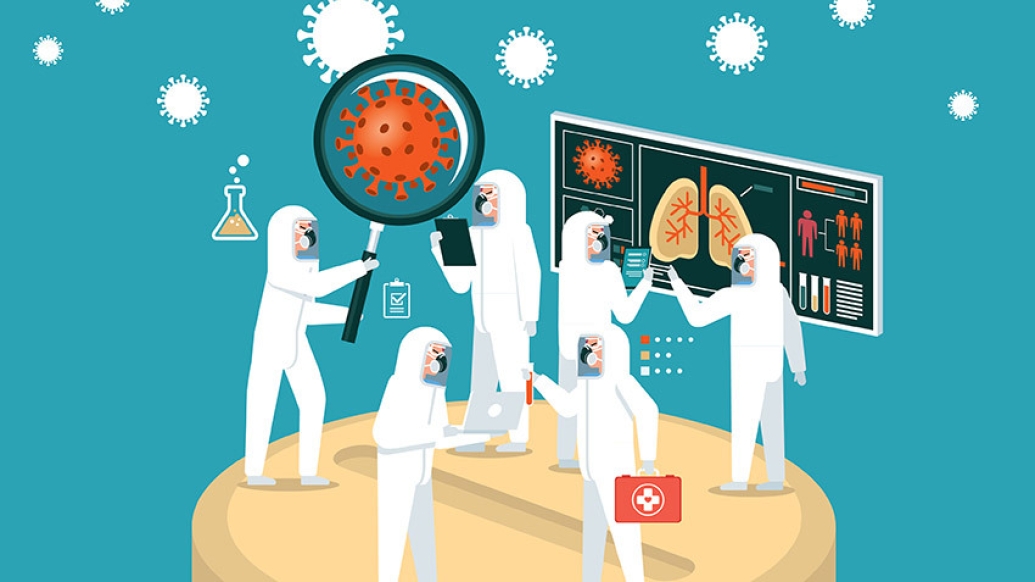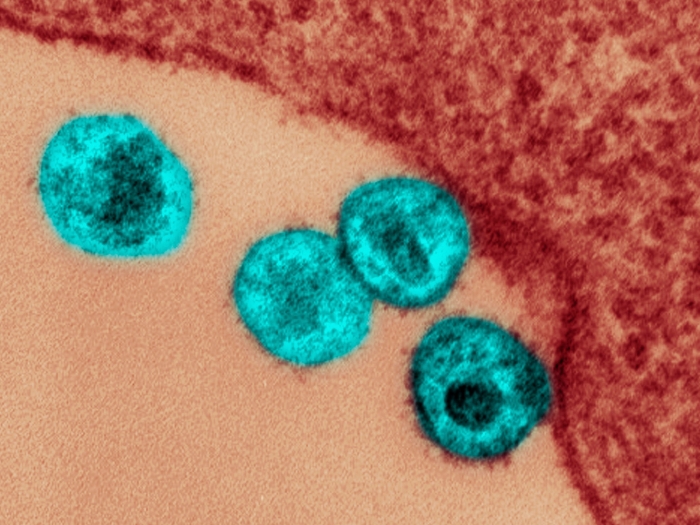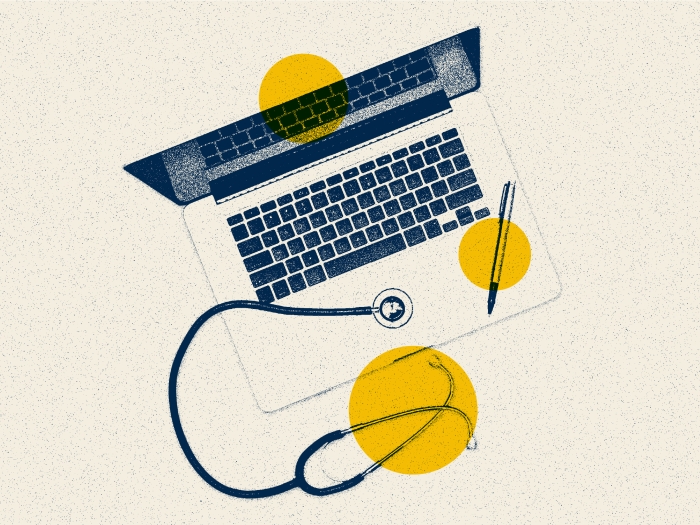Thanks to healthcare all-stars, the world enters 2021 optimistically with more clues than ever before about defeating the pandemic.
3:12 PM
Author |

In a year most have never seen the likes of (minus a very few who were alive during the 1918 flu pandemic), health experts raced to care for COVID-19 patients while scientists rushed to research labs looking for answers in hopes to stop the deadly pandemic in its tracks.
As 2020 comes to a close, and while the pandemic war rages on, the Michigan Health Lab rounded up and summarized what experts have learned about the disease over the past 12 months, shedding a hopeful light towards ending the pandemic once and for all in the new year.
1. How COVID-19 appears in lungs
Rolled out right at the beginning of the pandemic, a Michigan Medicine radiologist teamed up with an expert in China to focus on the appearance of the coronavirus in CT-scans. The pair discovered that the presence of lung nodules in both lungs and hazy-looking ground glass opacities should serve as an alert to radiologists that the disease may be present in certain patients, and remains a key finding for detection.
2. How COVID-19 (mostly) affects kids differently, and less often
A rare and potentially fatal inflammatory disease linked to the novel coronavirus, known as multi-system inflammatory syndrome, or MIS-C, was reported this year in a small number of pediatric cases. But one silver lining of the pandemic? Children seem mostly to be spared from the serious complications that come along with contracting the virus, and this seems to still hold true.
3. How COVID-19 was found to trigger blood clots
A study, published by Michigan Medicine researchers, discovered a new mechanism by which COVID-19 patients may develop blood clots. Researchers revealed how the virus seems to trigger the production of antibodies circulating through the blood, causing clots in people infected with the disease.
"Antibodies from patients with active COVID-19 infection created a striking amount of clotting in animals - some of the worst clotting we've ever seen," said co-corresponding author Yogen Kanthi, M.D., an assistant professor at the Michigan Medicine Frankel Cardiovascular Center and a Lasker Investigator at the National Institutes of Health's National Heart, Lung, and Blood Institute.
4. How digestive issues became a sign of COVID-19
Gastrointestinal issues, such as diarrhea, became a signal of infection as the virus continued to spread across the world. The primary symptoms of the disease were, at first, generally defined as having a fever, cough and shortness of breath.
5. How alarming COVID-19 racial disparities are
A disproportionate death rate from COVID-19 among Black Americans was revealed, the latest example in a long history of systemic inequities faced by Black Americans in the United States. Several studies published by researchers also helped to back this crucial and unsettling point: Researchers found Black patients were more likely to be hospitalized with COVID-19 than their white counterparts; a case series suggested Black men with a heart transplant may be at an increased risk of contracting COVID-19; and a new paper found pulse oximeters were less accurate in Black patients.
6. How COVID-19 induced cytokine storms in patients
Cytokine storms are life-threatening inflammatory syndromes that can be triggered by disease and have become a constant obstacle seen in people battling the coronavirus.
Researchers at Michigan Medicine created an experimental device to help combat these storms by changing the phenotype of circulating white blood cells, which helped to wean two patients off ECMO. Another prominent study, led by U-M investigators, found critically ill COVID-19 patients who received a single dose of tocilizumab were 45% less likely to die overall, and more likely to be out of the hospital or off a ventilator one month after treatment. Other U-M experts also discovered the presence of a protein on the surface of some kidney cells that may explain why the kidneys have been a hotspot for these storms.
7. How new equipment was needed, and thus urgently created, to assist in the COVID-19 battle
With quick, innovative thinking, U-M clinicians and researchers created new negative pressure environment devices, a helmet and a tent, that protected health care workers while treating patients with COVID-19. And as cases continued to soar, U-M teams worked fast to expand ventilator capacity by inventing an individualized vent-splitter that could allow multiple patients to receive customized pressures while sharing a single ventilator.
MORE FROM THE LAB: Subscribe to our weekly newsletter
8. How ECMO and ventilators have been crucial for patients during the pandemic
Short for extracorporeal membrane oxygenation, the ECMO device has been used for decades and was created by U-M's own Robert Bartlett, M.D., back in the early 1980s. U-M researchers found that after COVID-19 patients were placed on ECMO, their actual death rate was less than 40%. The study, co-lead by Ryan Barbaro of Michigan Medicine, strongly supported for the use of ECMO in the worst-hit patients.
And ventilators made headlines as countless were used to save patients' lives, while supplies dwindled in many hospitals across the country. As a way to help, Michigan Medicine experts outlined 20 evidence-based practices that were shown to reduce time spent on a ventilator and death in patients with acute respiratory failure and acute respiratory distress, which has overlap with patients who have severe COVID.
9. How dissecting the genome behind SARS-CoV-2 provided more information about the disease
Virus samples taken from people with the disease helped virologists and epidemiologists create what is known as a phylogenetic tree, which lines up the genetic codes from each virus sample to see who's related to whom. This research assisted in determining that New York City may have been the original epicenter of the United States epidemic and that initial cases were likely imported from Europe.
10. How potential COVID-19 drugs and treatments were discovered
At first, no therapies were proven to prevent or treat COVID-19, but as various therapies, like the now disproven hydroxychloroquine, filled the news, older drugs emerged as heroes. Michigan Medicine researchers outlined how a 60 year old corticosteroid can be used to save the lives of many with severe COVID-19. In addition, infectious disease experts now have therapies like monoclonal antibodies to help keep those at risk of severe disease from being hospitalized.
11. How rehab has been essential for recovered COVID-19 patients
Although those who survived hospital stays were deemed to be success stories, providers began to realize their recovery journeys were far from over: Patients hospitalized from COVID-19 where found to need physical and cognitive rehabilitation care to aid in their recovery from the virus' severe and damaging effects on the body and brain.
12. How COVID-19 was found in post-mortem corneal tissue
A multi-institutional study found that COVID-19 can be found in conjunctival swabs and tears of infected patients, according to an article in The Ocular Surface. Researchers from Michigan Medicine's Kellogg Eye Center discovered the virus can infiltrate corneal tissue, which could be used for transplantation in the U.S.
This has raised concerns about organ donations and whether or not the disease could be transmitted to a healthy recipient. But Shahzad Mian, M.D., the senior author on the study, says this is notable to be aware of during the organ screening process:
"There's no evidence to suggest COVID-19 can be transmitted from a corneal transplant, but our data assures us that a screening process to determine who's positive for the virus and who isn't is important to make sure we do everything in case there is a potential risk of transmission."

Explore a variety of healthcare news & stories by visiting the Health Lab home page for more articles.

Department of Communication at Michigan Medicine
Want top health & research news weekly? Sign up for Health Lab’s newsletters today!





